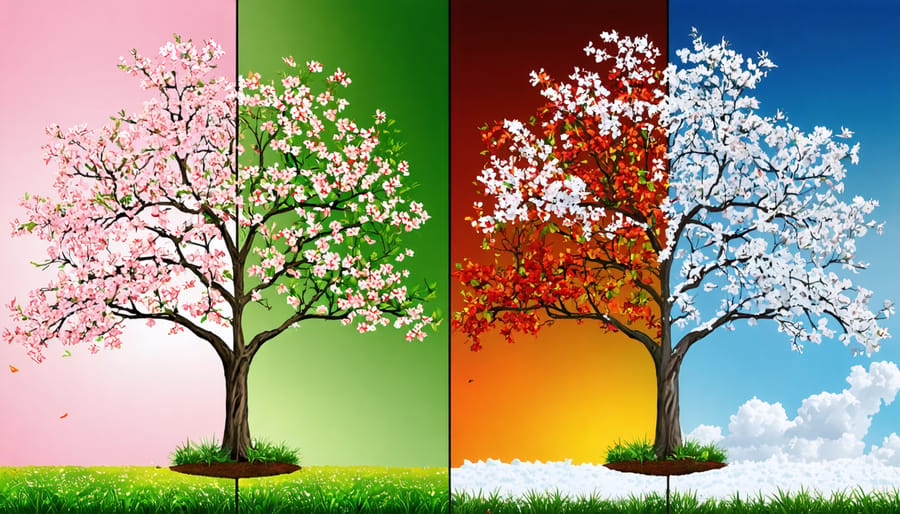Protect young saplings from intense sunlight during their critical first growing season by creating movable shade barriers with burlap or shade cloth mounted on wooden stakes. Monitor newly planted trees for signs of sun stress – curled leaves, yellow patches, or wilting – and adjust shade coverage accordingly. Position natural shade providers like tall container plants or climbing vines on trellises to offer dappled light without completely blocking essential morning sun. Install shade structures that can be easily modified throughout the seasons, allowing more light exposure during spring and fall while maximizing protection during intense summer afternoons. This thoughtful balance of sun and shade helps young trees develop strong root systems and healthy canopies without the setbacks of sun scorch or drought stress.
Why Young Trees Need Shade Protection

Signs Your Tree Needs Shade Protection
Just like humans can get sunburned, trees show clear signs of tree stress when they’re getting too much sun. The most obvious indicator is leaf scorch, where leaves become crispy and brown around the edges, especially on the side facing direct afternoon sun. You might also notice leaves that appear bleached or yellowed, particularly during the hottest parts of summer.
Watch for wilting leaves even when the soil is moist – this suggests your tree is losing water faster than it can absorb it due to intense sun exposure. New trees might develop slow or stunted growth, and their bark could show signs of sunscald, appearing cracked or discolored on the south or southwest-facing side.
If your young tree’s leaves are curling inward or developing dry, brittle patches, it’s crying out for shade protection. You might also spot premature leaf drop or branches dying back, especially on the sunniest side of the tree. These symptoms typically appear more pronounced during hot afternoon hours or during heat waves, so pay extra attention during these times.
Natural Shade Solutions
Companion Planting Strategies
Companion planting is a clever way to protect your young trees while making the most of your garden space. Fast-growing vegetables like pole beans, tall sunflowers, and climbing peas can create natural shade screens during the crucial first growing season. Position these plants on the western and southern sides of your sapling, where afternoon sun exposure is most intense.
Tall ornamental grasses like switchgrass or miscanthus work beautifully as temporary shade providers and add year-round visual interest. Plant them in clusters about 2-3 feet from your young tree, ensuring they won’t compete for nutrients. For immediate coverage, consider planting sprawling squash or pumpkins nearby – their large leaves provide excellent shade while keeping the soil cool and moist.
Hardy annuals like cosmos and cleome can form a protective curtain around young trees while attracting beneficial pollinators to your garden. Remember to space companion plants far enough from your tree’s trunk to prevent root competition, typically 18-24 inches away. As your tree grows stronger and taller, gradually remove or relocate these companion plants to give your tree the space it needs to thrive.

Artificial Shade Options
DIY Shade Solutions
Creating your own shade structure for young trees is both cost-effective and rewarding. Start with four wooden stakes or bamboo poles (at least 4 feet tall) positioned in a square around your tree, about 2-3 feet from the trunk. Drive these stakes roughly 6 inches into the ground for stability.
For a basic shade structure, stretch shade cloth or burlap between the stakes, securing it with garden twine or clips. Leave about 12 inches of space at the bottom for air circulation. The material should be taut but not pulling the stakes inward.
A more adaptable solution involves creating a removable canopy. Thread grommets into the corners of your shade material, then attach it to the stakes using bungee cords or strong clips. This allows you to easily adjust or remove the cover as needed.
For smaller trees, you can fashion a protective cylinder using hardware cloth or window screening. Roll the material into a tube shape, securing it with zip ties, and place it around the tree. This provides filtered light while protecting the trunk from sun scald.
Remember to check your DIY structure regularly, especially after strong winds or rain, and adjust as needed to maintain proper protection without restricting tree growth.

Seasonal Shade Adjustments
Just as your trees adapt to changing seasons, your shading strategy should evolve throughout the year. During intense summer months, young trees benefit from maximum protection, especially during peak afternoon hours. Consider using 30-40% shade cloth during this period to prevent leaf scorch while still allowing essential light through.
As autumn approaches, gradually reduce shade coverage to help your tree prepare for winter dormancy. This season-smart tree care approach helps build resilience in your young trees. You might start by removing shade protection for a few hours in the morning, then progressively increase exposure over several weeks.
Spring calls for a balanced approach – be ready to provide shade on unexpectedly warm days while allowing full sun exposure during mild weather. Keep your shade materials handy but use them selectively. During winter, most deciduous trees won’t need shade protection, but evergreens might benefit from partial coverage during harsh winter sun, particularly in snowy conditions where reflection can intensify light exposure.
Remember to check your trees regularly for signs of stress and adjust protection accordingly. What works in one season might need tweaking in another as your tree establishes itself.
Protecting young trees with proper shade is essential for their survival and healthy growth. By implementing the right shading techniques, choosing appropriate materials, and monitoring sun exposure throughout the seasons, you’ll give your saplings the best chance to thrive. Remember to adjust protection as needed and gradually reduce shade as your tree establishes itself. With these simple steps, you’re not just planting a tree – you’re nurturing a legacy that will provide beauty, shade, and environmental benefits for generations to come. Happy tree growing!




